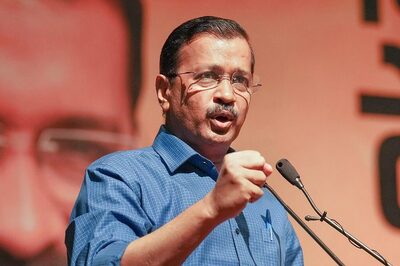
views
Finance Minister Nirmala Sitharaman on Monday tabled the Economic Survey 2023-24 in Parliament, setting the stage for the Union Budget 2024-25 which will be presented in Lok Sabha tomorrow, Tuesday. The latest Economic Survey remains bullish on India’s growth and macroeconomic outlook. It pegged India’s GDP growth for FY25 at 6.5-7 per cent and the country’s inflation lower at 4.5 per cent. Here are the highlights of the Economic Survey 2023-24:
Also Read: Economic Survey 2024 Live Updates: CEA Nageswaran Backs More Chinese Direct Investment To Boost India’s Exports
India’s Current Macroeconomic Environment
The Indian economy is on a strong wicket and stable footing, demonstrating resilience in the face of geopolitical challenges. The Indian economy has consolidated its post-Covid recovery with policymakers – fiscal and monetary – ensuring economic and financial stability. Nonetheless, change is the only constant for a country with high growth aspirations.
“For the recovery to be sustained, there has to be heavy lifting on the domestic front because the environment has become extraordinarily difficult to reach agreements on key global issues such as trade, investment and climate,” according to the latest Economic Survey 2023-24.
India’s GDP Growth
The Survey projects a real GDP growth rate of 6.5 per cent-7 per cent. Domestic growth drivers have supported economic growth in FY24 despite uncertain global economic performance. Improved balance sheets will help the private sector cater to strong investment demand. A normal rainfall forecast by the India Meteorological Department and the satisfactory spread of the southwest monsoon thus far are likely to improve agriculture sector performance and support the revival of rural demand. Structural reforms such as the GST and the IBC have also matured and are delivering envisaged results, according to the Survey.
India’s Inflation Trend
According to the latest Economic Survey 2023-24, inflationary pressures stoked by global troubles, supply chain disruptions, and vagaries of monsoons have been deftly managed by administrative and monetary policy responses. As a result, after averaging 6.7 per cent in FY23, retail inflation declined to 5.4 per cent in FY24.
It said the decrease in retail inflation in FY24 was driven by a fall in core inflation – both goods and services. Core services inflation eased to a nine-year low in FY24; at the same time, core goods inflation also declined to a four-year low.
Food inflation has been a global concern over the past two years. Within India, the agriculture sector faced challenges due to extreme weather events, depleted reservoirs, and crop damage, which impacted farm output and food prices. Consequently, food inflation stood at 6.6 per cent in FY23 and increased to 7.5 per cent in FY24, according to the Survey.
Going forward, the RBI projects inflation to fall to 4.5 per cent in FY25 and 4.1 per cent in FY26, assuming normal monsoon and no external or policy shocks. Similarly, the IMF forecasts inflation of 4.6 per cent in 2024 and 4.2 per cent in 2025 for India, it added.
India’s Fiscal Position & External Outlook
The fiscal balances of the general government have improved progressively despite expansionary public investment. Tax compliance gains driven by procedural reforms, expenditure restraint, and increasing digitisation helped India achieve this fine balance, according to the Economic Survey 2023-24.
The external balance has been pressured by subdued global demand for goods, but strong services exports largely counterbalanced this. As a result, CAD stood at 0.7 per cent of the GDP during FY24, an improvement from the deficit of 2.0 per cent of GDP in FY23.
“Against the global trend of widening fiscal deficit and increasing debt burden, India has remained on the course of fiscal consolidation. The favourable fiscal performance in 2023, emerged as the cornerstone of India’s macroeconomic stability,” the Economic Survey said.
It added that the fiscal deficit of the Union Government has been brought down from 6.4 per cent of GDP in FY23 to 5.6 per cent of GDP in FY24, according to provisional actuals (PA) data released by the Office of Controller General of Accounts (CGA).
India’s external sector remained strong amidst on-going geopolitical headwinds accompanied by sticky inflation, it said.
India’s Medium-Term Outlook
The medium-term growth outlook will happen in the context of the following global trends, namely, increased geo-economic fragmentation, a global push for self-reliance, looming climate change, rise of technology as the biggest strategic differentiator and limited policy space for countries across the world.
Key areas of policy focus in the short to medium term include job and skill creation, tapping the full potential of the agriculture sector, addressing MSME bottlenecks, managing India’s green transition, deftly dealing with the Chinese conundrum, deepening the corporate bond market, tackling inequality and improving our young population’s quality of health, according to the Survey.
Amrit Kaal Growth Strategy
The growth strategy for Amrit Kaal is predicated on six key areas. Firstly, there must be a deliberate focus on boosting private investment. Secondly, the growth and expansion of India’s Mittelstand (MSMEs) is a strategic priority. Thirdly, the potential of agriculture as an engine of future growth must be recognised and policy impediments removed. Fourthly, there is a need to secure the financing of green transition in India. Fifthly, the education-employment gap must be bridged. And finally, focused building of state capacity and capability is required for sustaining and accelerating India’s progress.
Healthcare and Education
According to the Economic Survey 2023-24, the Indian economy is moving forward with a reformed approach to welfare, focused on empowerment, saturation approach, universal access to necessities, efficiency, cost-effectiveness, and enhanced participation of the private sector and civil society.
The education sector is bustling with the across-the-board transformation led by the NEP 2020, focusing on Foundational Literacy and Numeracy for every child passing the third standard. The ‘Poshan bhi Padhai bhi’ programme for early childhood education aims to develop the world’s largest, universal, high-quality preschool network at Anganwadi Centres.
In healthcare, Ayushman Bharat is not only saving lives but also saving generations from the debt trap. More than 34.7 crore Ayushman Bharat cards have been generated, and the scheme has covered 7.37 crore hospital admissions. Considering the multiplier effect of low costs, the scheme saves more than 1.25 lakh crore of out-of-pocket expenditure for poor and deprived families.
Employment and Skill Development
According to the Economic Survey 2023-24, Indian labour market indicators have improved in the last six years, with the unemployment rate declining to 3.2 per cent in 2022-23. Rising youth and female participation in the workforce presents an opportunity to tap the demographic and gender dividend.
The net payroll additions under EPFO have more than doubled in the past five years, signalling healthy growth in formal employment.
The Government has implemented measures to boost employment, foster self-employment, and promote worker welfare.
The rise in the number of candidates undergoing skill development through the Government’s flagship programmes has underlined the thrust to ‘Skill India’.
The Economic Survey 2023-24 also said the Indian economy needs to add 7.85 million jobs every year until 2030 in the non-farm sector.




















Comments
0 comment